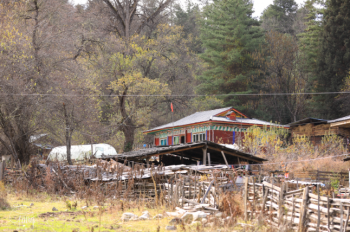Gawalung Monastery: Difference between revisions
Yeshedorje (talk | contribs) mNo edit summary |
mNo edit summary |
||
| (2 intermediate revisions by 2 users not shown) | |||
| Line 4: | Line 4: | ||
==Location== | ==Location== | ||
Gawalung monastery is located close to the township of | Gawalung monastery is located close to the township of Tramog (aka Bome, or Pomi), on the banks of the [[Yarlung Tsangpo]] in [[Powo]], and faces the Gawalung forests.<Ref>It is located between 95° and 96° width and 29° height on map of East Tibet, Gecko Maps, A. Rohweder, Switzerland.</Ref><Ref>Emeric Yeshe Dorje, The History of the Düdjom Tersar Lineage, forthcoming.</Ref> | ||
==Foundations== | ==Foundations== | ||
| Line 13: | Line 13: | ||
==Developments== | ==Developments== | ||
The most famous of the lamas in Gawalung monastery was [[Taksham Nüden Dorje]], who discovered [[terma]]s at the place. For many successive incarnations of the Taksham Tulkus, Gawalung Monastery was directly supported by the | The most famous of the lamas in Gawalung monastery was [[Taksham Nüden Dorje]], who discovered [[terma]]s at the place. For many successive incarnations of the Taksham Tulkus, Gawalung Monastery was directly supported by the Kanam Depa—the line of kings of Powo. <Ref>Phurbu rdo rje (1988), sPo bo lo rgyus, [History of Powo], Lhasa: Bod ljongs mi dmangs dpe skrun khang.</Ref> | ||
At the time of the Sixth Taksham Tulku, the monastery was destroyed by fire and reconstructed after that. The Kanam Depa acted as a sponsor for the monastery.<Ref> Schwieger, Peter (2002): A Preliminary Historical Outline of the Royal Dynasty of sPo-bo, in: Tractata Tibetica et Mongolica. Festschrift für Klaus Sagaster zum 65. Geburtstag. Wiesbaden, p. 223.</Ref> | At the time of the Sixth Taksham Tulku, the monastery was destroyed by fire and reconstructed after that. The Kanam Depa acted as a sponsor for the monastery.<Ref> Schwieger, Peter (2002): A Preliminary Historical Outline of the Royal Dynasty of sPo-bo, in: Tractata Tibetica et Mongolica. Festschrift für Klaus Sagaster zum 65. Geburtstag. Wiesbaden, p. 223.</Ref> | ||
| Line 30: | Line 30: | ||
==External Links== | ==External Links== | ||
* | *{{TBRC|G1KR1886|TBRC}} | ||
[[Category: Tibet]] | [[Category: Tibet]] | ||
[[Category:Powo]] | [[Category:Powo]] | ||
[[Category:Nyingma Monasteries]] | [[Category:Nyingma Monasteries]] | ||
Latest revision as of 14:44, 9 April 2022

Gawalung Monastery, aka Gawalung Gön (Tib. དགའ་བ་ལུང་དགོན་, Wyl. dga’ ba lung dgon), Dodung Monastery (Tib. རྡོ་དུང་དགོན་པའམ་དགའ་བ་ལུང་དགོན་, Wyl. rdo dung gdon) is a Nyingma monastery in Powo founded by Taksham Nüden Dorje.
Location
Gawalung monastery is located close to the township of Tramog (aka Bome, or Pomi), on the banks of the Yarlung Tsangpo in Powo, and faces the Gawalung forests.[1][2]
Foundations
Gawalung monastery, was founded by Taksham Nüden Dorje, the first incarnation of the Taksham Tulku.
Description
Its main temple featured a statue of Padmasambhava and, among other supports it had a silver reliquary stupa of Taksham Nüden Dorje.
Developments
The most famous of the lamas in Gawalung monastery was Taksham Nüden Dorje, who discovered termas at the place. For many successive incarnations of the Taksham Tulkus, Gawalung Monastery was directly supported by the Kanam Depa—the line of kings of Powo. [3]
At the time of the Sixth Taksham Tulku, the monastery was destroyed by fire and reconstructed after that. The Kanam Depa acted as a sponsor for the monastery.[4]
Main Lineages
The main lineage practiced is the termas of Taksham Nüden Dorje.
Main Teachers
The Taksham Tulku, with eight incarnations, are the main teachers of Gawalung monastery.
Notes
- ↑ It is located between 95° and 96° width and 29° height on map of East Tibet, Gecko Maps, A. Rohweder, Switzerland.
- ↑ Emeric Yeshe Dorje, The History of the Düdjom Tersar Lineage, forthcoming.
- ↑ Phurbu rdo rje (1988), sPo bo lo rgyus, [History of Powo], Lhasa: Bod ljongs mi dmangs dpe skrun khang.
- ↑ Schwieger, Peter (2002): A Preliminary Historical Outline of the Royal Dynasty of sPo-bo, in: Tractata Tibetica et Mongolica. Festschrift für Klaus Sagaster zum 65. Geburtstag. Wiesbaden, p. 223.